Features of cleaning grates made of different materials
In most cases, the grate of a gas stove is made of cast iron alloy, stainless steel or metal with an enamel coating. Methods for cleaning it at home are chosen depending on the base material.
Cast iron grates
Due to its good thermal conductivity, a metal alloy (cast iron) is often preferred as the main material for the grate. However, it must be handled with great care.
The surface of cast iron rods is easily damaged when cleaning with abrasive compounds and acids. For this reason, you should avoid using aggressive chemicals and not treat the rods with hard metal brushes.
The best way to remove carbon deposits and grease from cast iron is calcination or steam treatment.
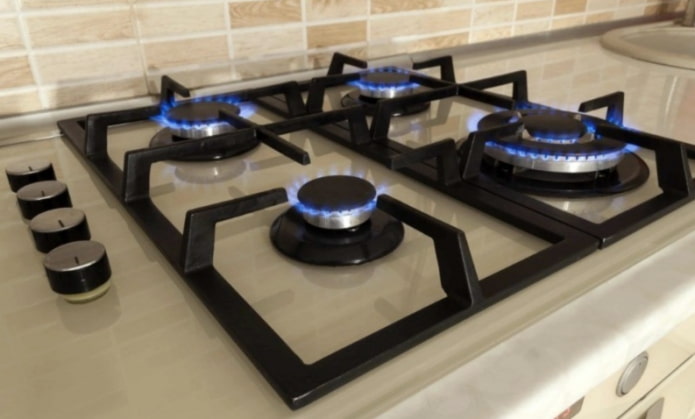
Steel grates
Steel is very durable and, unlike cast iron, is resistant to abrasive treatment. And although their service life is short due to the low thermal stability of the base material, they are easy to care for.
Most often, steel grates are cleaned at home in a dishwasher using household detergents. You can manually process the product using washing powder, soda ash, sand. Acid-based products are also suitable.
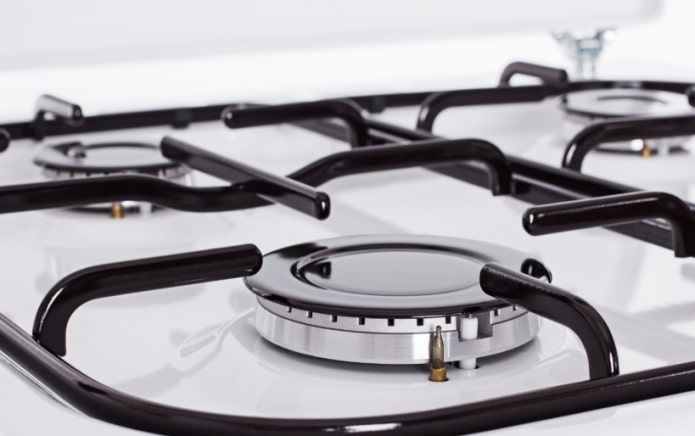
Enameled grates
Enamel improves the aesthetic characteristics of the product and collects less dirt. However, they are susceptible to scratches when treated with abrasive and aggressive chemicals. Therefore, you should avoid using metal brushes and strong household chemicals.
Enameled grates are usually cleaned in a dishwasher or manually with specialized cleaning creams. However, they can be expensive, so you can use folk methods, such as treating them with a paste based on mustard powder or a weak vinegar solution. Silicate glue is also used.
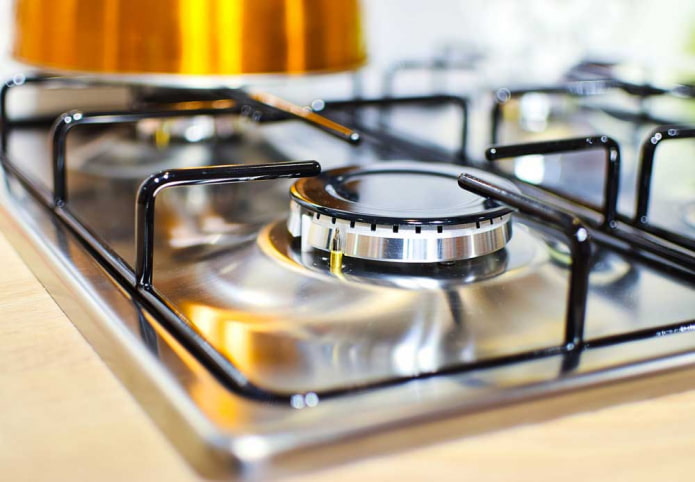
Working cleaning methods
There are a large number of cleaning methods that help to deal with dirt quickly and effectively. Among them, there are several of the most effective.
Hot solution of laundry soap
Treatment with a solution of laundry soap is the most popular method of cleaning a gas stove. It effectively removes any type of dirt: carbon deposits, soot, grease deposits.
Stages of treatment with soap solution:
- The grates must be removed from the stove and placed in the sink (or plastic container).
- Then plug the sink hole. Pour boiling water into it, in which a small amount of liquid soap (or grated solid soap) is dissolved.
- Leave for 15 minutes.
- Wipe the grate with a hard sponge, paying particular attention to areas with old stains.
- Rinse with clean running water for several minutes.
- Dry the grate and place it on the stove.
If the grate is heavily soiled and covered with old stains, also mix a drop of any detergent with an “anti-fat” effect or a little vinegar into the hot water. It helps to enhance the cleaning ability of the composition and soften the layers.
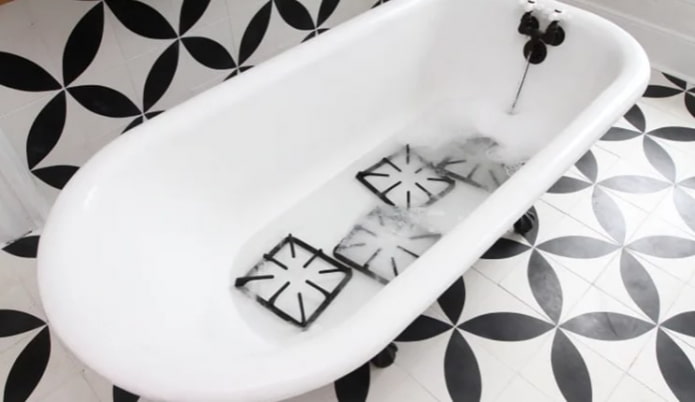
Baking soda paste
Soda can cope with old grease and carbon stains, since when mixed with water it forms a slightly alkaline solution. At the same time, it is considered an inexpensive and accessible material.
Stages of processing with a composition with baking soda:
- Remove the gas stove grate.
- Completely cover the surface with a thick paste, previously prepared in a container by mixing soda and a small amount of warm purified water (you can add a little detergent or vinegar).
- Leave for 1 hour.
- Wash off the dirt with a damp brush.
- Rinse the product with clean water.
- Dry well and install on the gas stove.
Since soda is a soft abrasive, it can be used when processing structures made of different materials. It not only effectively corrodes the layer of fat and carbon deposits, but also removes unpleasant odors and prevents the proliferation of pathogenic microorganisms. Its effectiveness can be enhanced by adding a little vinegar. When using these substances, you should wear gloves.
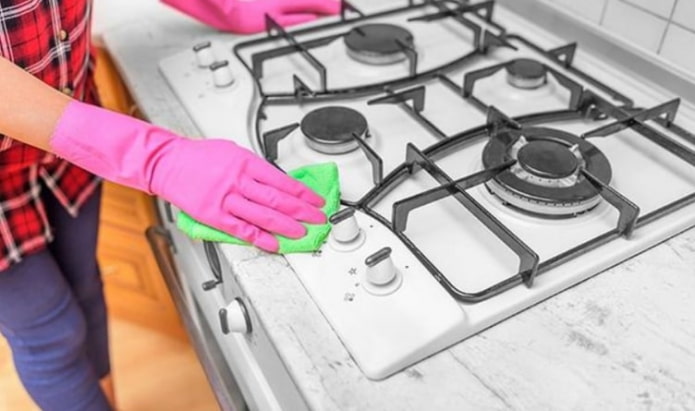
Mustard powder
A good way to clean the grate of a gas stove from carbon deposits and soot is to treat it with a paste based on mustard powder. This substance belongs to the group of soft abrasives and copes well with most old dirt.
Stages of processing the grate:
- Wet the gas stove grate with clean water.
- Apply a thick paste-like mixture made from mustard powder and a small amount of hot water.
- Leave for 2 hours.
- Wipe the bars with a hard brush, then rinse the remaining dirt with clean water.
- Dry well.
Mustard powder is non-toxic, unlike aggressive chemicals. Moreover, it disinfects surfaces and prevents the development of pathogenic microorganisms. However, it does not foam and is quickly consumed, so it is not considered an economical product.
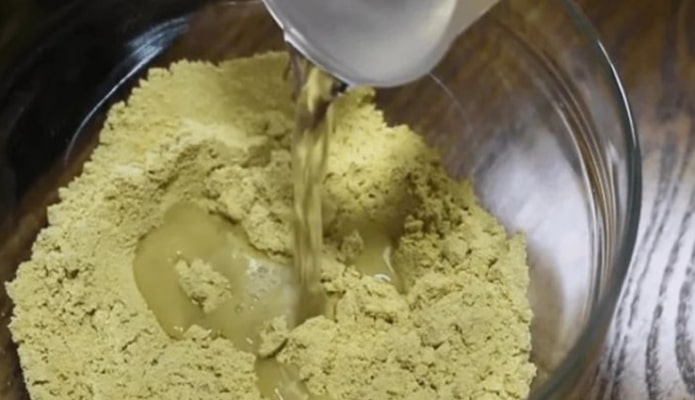
Ammonia
Ammonia, or an aqueous solution of ammonia (10%), has a highly alkaline reaction and effectively destroys stubborn grease stains and carbon deposits. Therefore, it is easy to clean the grate of a gas stove with it.
Stages of cleaning with ammonia:
- The grate must be placed in a large plastic bag.
- Then put on gloves and pour 3 tbsp inside. ammonia.
- Tie the bag (or seal it) and leave it for 8-12 hours.
- After the specified time, remove the grate and wash off the greasy stains, which now easily peel off from the surface of the structure. Clean with a household detergent using a soft kitchen brush.
- Dry and place on the stove.
The ammonia solution has a sharp, repulsive odor and is highly toxic. Therefore, it is recommended to tie the bag well and wrap it in a second layer of polyethylene. You should also ensure effective air circulation inside the room.
Fire Calcination
Calcination over an open fire is the most effective way to clean a cast iron grate from grease and carbon deposits. The alloy can withstand high-temperature treatment.
Stages of cleaning by calcination:
- Remove the structure from the stove and place it on a sheet of metal.
- Fill with sand, completely covering the product.
- Place the metal sheet over an open fire and calcine for 2-3 hours until the fat burns out.
- Remove the grate from the fire, cool in natural conditions.
- Thoroughly clean from dirt residues, rinse with water and dry.
Calcination is also carried out in domestic conditions. Place the metal product over lit burners or a blowtorch. Periodically change its position so that all areas of the structure are evenly heated and cleaned of dirt. However, it is worth remembering that when the fat layer burns out, toxic volatile substances are released, so when calcining a metal product, be sure to turn on the kitchen hood and open the window to ensure air circulation in the room.
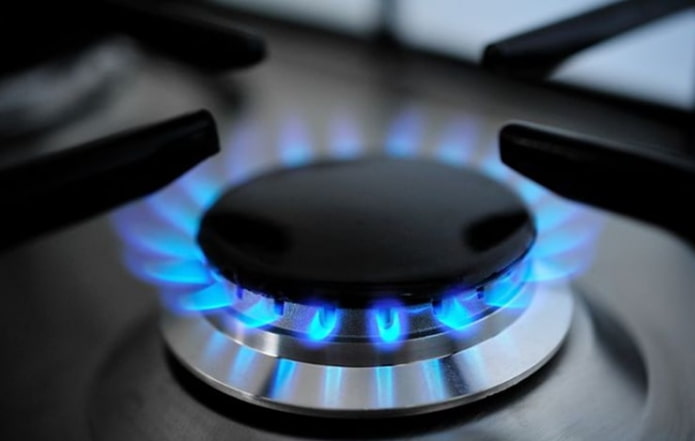
Steam Generator Treatment
An effective way to clean grates of any type is steam treatment. This is the most gentle method, which does not damage the surfaces.
Stages of steam treatment:
- The structure is removed and placed on a baking sheet in the oven, closer to the middle.
- A container of water is placed under the baking sheet.
- Preheat the oven to a temperature of +40…+80°C and leave for several hours.
- Then remove the grate from the baking sheet and wash off the dirt with a damp cloth.
- Dry and install on the stove.
The structure can be cleaned without dismantling. For this purpose, a household steam generator is used: all areas are treated with a jet for several minutes. After that, the dirt can be easily washed off.
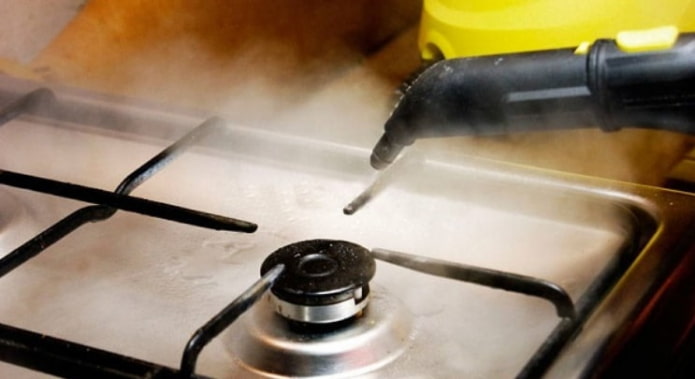
Using a melamine brush
A cleaning melamine sponge (eraser) is made of foam material, which belongs to the category of light abrasives. It forms foam that breaks down the fat layer and carbon deposits. To effectively clean the grate with such an eraser, you only need clean water. Pre- or post-treatment with chemicals is not required.
Stages of processing the structure with a melamine eraser:
- Remove the structure from the stove.
- Wet the melamine eraser with warm water, the temperature of which is about +36°C.
- Slightly squeeze out the moisture. As soon as the material begins to foam, begin cleaning: consistently and carefully remove dirt from the rods.
- Then rinse with a damp cloth or sponge.
- Dry and install on the stove.
It is easy to clean enamel, steel, cast iron grates with a melamine sponge. It removes most stubborn stains.
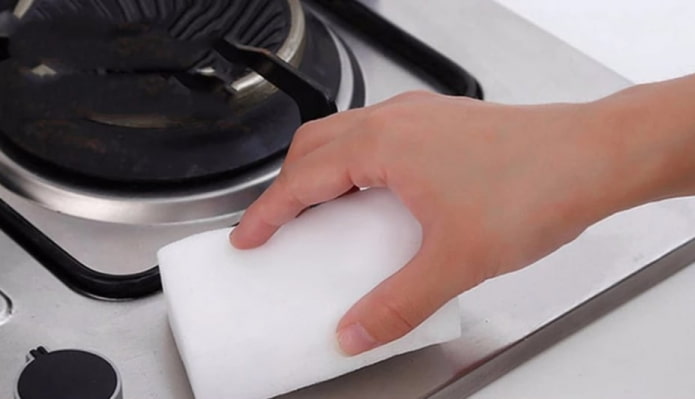
Prevention
The best way to maintain frequency is to take preventive measures. To prevent soot and grease from accumulating on the bars, it is recommended to:
- wipe the surface with a dry sponge after each meal preparation;
- in case of heavy contamination, immediately remove stains with a solution of laundry soap;
- carry out scheduled cleaning weekly.
If the rules are followed, the structure retains an attractive appearance and serves for a long time.
When cleaning, be sure to wear gloves, and when using aggressive chemicals – protective equipment respiratory organs.
Now reading:
- Warm, daylight or cold light? Tips for choosing and using in the interior.
- Children’s pillows: recommendations for selection and types of fillers
- Features of chalet-style house design (32 photos) – facade, roof and superstructures.
- Three easy and effective ways to fix a cabinet hinge that has been torn out.
- Brown curtains: 97 stylish photos and ideas for window decoration in the interior.